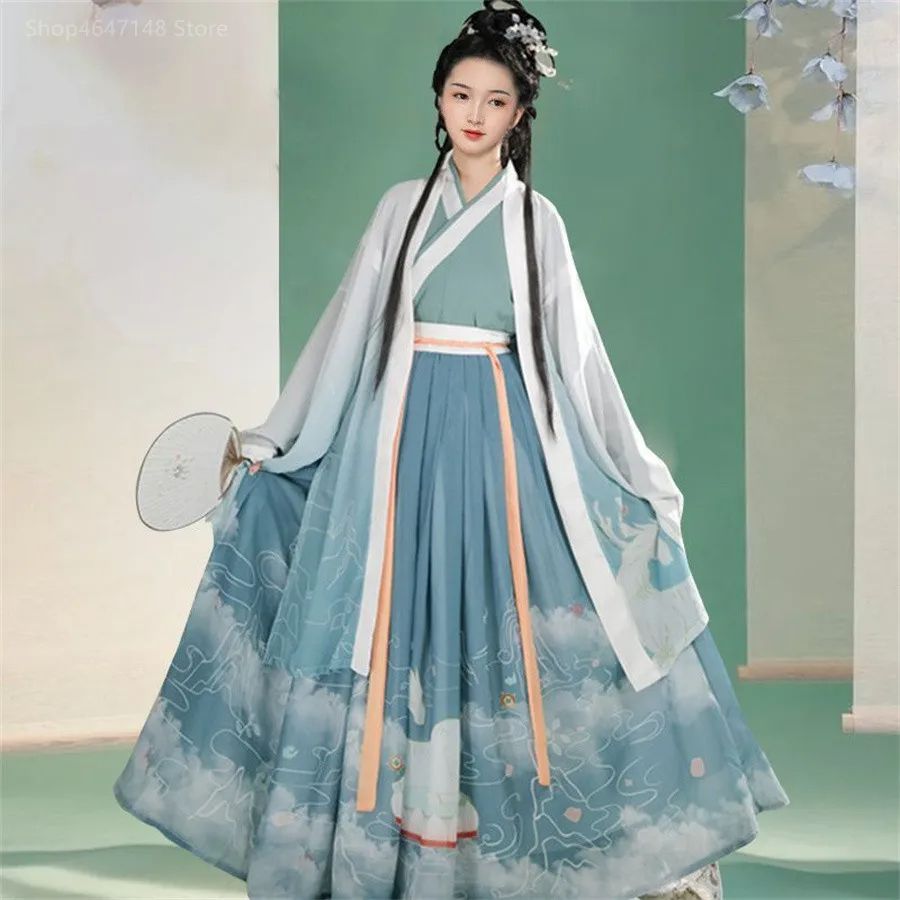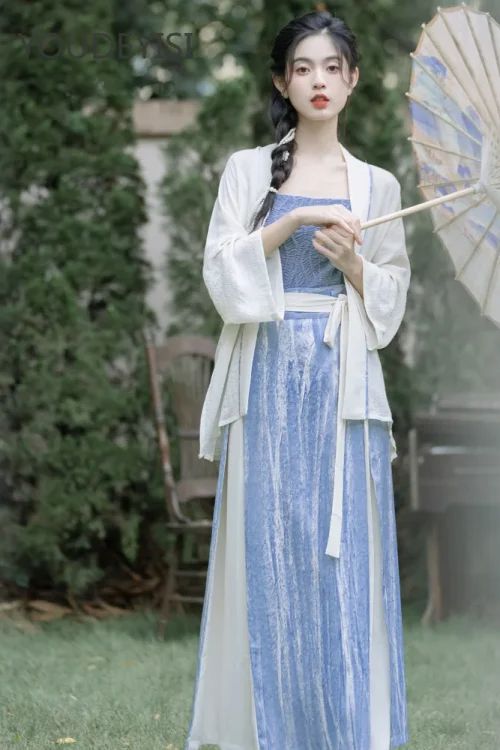The Historical Evolution of Water Wave Patterns on Hanfu
The water wave pattern, a timeless motif in Chinese art and culture, has found its exquisite expression on Hanfu, the traditional pakaian of the Han Chinese. Its evolution through history reflects the changing aesthetics and cultural influences that have shaped Hanfu over centuries.

Emergence in the Dinasti Han
During the Han dynasty (206 BCE – 220 CE), the water wave pattern emerged as a subtle embellishment on silk pakaian. Inspired by the gentle ripples of water, it symbolized fluidity and grace. As Hanfu evolved during the Tang dynasty (618 – 907 CE), the water wave pattern became more prominent, adorning robes and skirts with its flowing lines. The influence of Buddhism and the Silk Road brought new artistic elements, resulting in intricate and stylized water wave designs.
Zenith in the Dinasti Song
In the Song dynasty (960 – 1279 CE), the water wave pattern reached its zenith of popularity. It became a defining characteristic of Song Hanfu, particularly in the form of the “ruqun,” a long, flowing skirt. The pattern was often combined with other auspicious motifs, such as clouds and cranes, to create a harmonious and elegant ensemble.
Changes in the Dinasti Ming
During the Ming dynasty (1368 – 1644 CE), the water wave pattern continued to be a staple of Hanfu, but its style underwent a subtle shift. The lines became more angular and geometric, reflecting the influence of Ming architecture and painting. The pattern was often used in combination with other decorative elements, such as embroidery and beading.
Decline in the Qing Dynasty
In the Qing dynasty (1644 – 1912 CE), the water wave pattern experienced a decline in popularity as Hanfu was gradually replaced by Manchu clothing. However, it remained a cherished motif in traditional Chinese textiles and was revived in the 20th century as part of the Hanfu revival movement.
Modern Usage
Today, the water wave pattern continues to grace modern Hanfu designs, embodying the timeless beauty and cultural heritage of this ancient garment. It serves as a reminder of the rich artistic traditions that have shaped Chinese culture throughout history.
The Cultural Significance of Water Wave Patterns in Hanfu
The water wave pattern, a ubiquitous motif in Hanfu, the traditional clothing of the Han Chinese, has undergone a captivating evolution throughout history. Its origins can be traced back to the Shang dynasty (c. 1600-1046 BCE), where it adorned bronzeware and pottery, symbolizing the life-giving properties of water.

Prominence in the Han Dynasty
During the Han dynasty (206 BCE-220 CE), the water wave pattern gained prominence in textiles, particularly in silk robes. It represented the fluidity and grace of water, embodying the feminine ideal of beauty. The pattern’s popularity continued into the Tang dynasty (618-907 CE), where it became an integral part of court attire, signifying elegance and refinement.
Stylization in the Song Dynasty
In the Song dynasty (960-1279 CE), the water wave pattern evolved into a more stylized form, with intricate curves and flowing lines. It adorned both men’s and women’s clothing, symbolizing harmony and prosperity. The pattern’s versatility extended to other art forms, such as ceramics and lacquerware.
Elaborate Designs in the Ming Dynasty
During the Ming dynasty (1368-1644 CE), the water wave pattern became more elaborate, with the addition of auspicious symbols such as dragons and phoenixes. It represented the emperor’s power and authority and was often used in imperial robes and official garments.
Shifts in the Qing Dynasty
In the Qing dynasty (1644-1912 CE), the water wave pattern continued to be popular, but its symbolism shifted towards longevity and good fortune. It adorned clothing, accessories, and even architectural elements, becoming a ubiquitous symbol of Chinese culture
Modern Significance
Today, the water wave pattern remains an integral part of Hanfu, representing the rich cultural heritage of the Han Chinese. It is incorporated into modern designs, blending tradition with contemporary aesthetics. The pattern’s enduring popularity is a testament to its timeless beauty and the enduring significance of water in Chinese culture.
Itu Modern Revival of Water Wave Patterns on Hanfu
The evolution of water wave patterns on Hanfu, a traditional Chinese garment, mirrors the ebb and flow of Chinese history and culture. Originating in the Song Dynasty (960-1279), these patterns initially adorned the robes of the elite, symbolizing their status and refinement.

Widespread Use in the Ming Dynasty
During the Ming Dynasty (1368-1644), water wave patterns became more widespread, appearing on garments worn by both men and women. The patterns grew more intricate, incorporating elements of nature such as flowers, birds, and fish. This period also saw the emergence of the “cloud and water” pattern, a combination of water waves and cloud motifs that represented harmony between heaven and earth.
Restriction and Stylization in the Qing Dynasty
In the Qing Dynasty (1644-1912), water wave patterns continued to be popular, but their use became more restricted. They were primarily reserved for formal occasions and worn by members of the imperial court. The patterns became more stylized and geometric, reflecting the influence of Western aesthetics.
Revival in Modern Times
After the fall of the Qing Dynasty, water wave patterns on Hanfu fell out of fashion. However, in recent years, there has been a resurgence of interest in traditional Chinese culture, leading to a revival of water wave patterns on Hanfu.
Contemporary Interpretations
Modern interpretations of water wave patterns on Hanfu are diverse and innovative. Some designers incorporate traditional motifs into contemporary designs, while others experiment with new colors and textures. The patterns are no longer confined to formal wear but are also found on casual garments and accessories.
Cultural Awakening and Fashion Trend
The revival of water wave patterns on Hanfu is not merely a fashion trend but a reflection of a deeper cultural awakening. It represents a renewed appreciation for Chinese heritage and a desire to connect with the past. As Hanfu continues to evolve, water wave patterns will undoubtedly remain an integral part of its rich tapestry, symbolizing the enduring beauty and resilience of Chinese culture.
